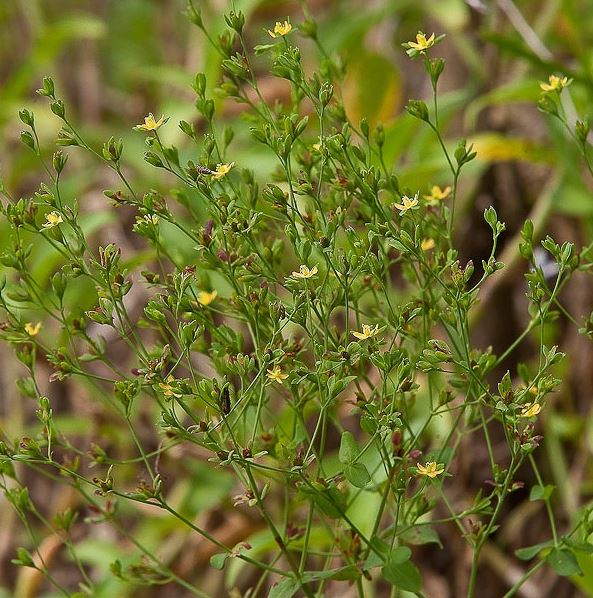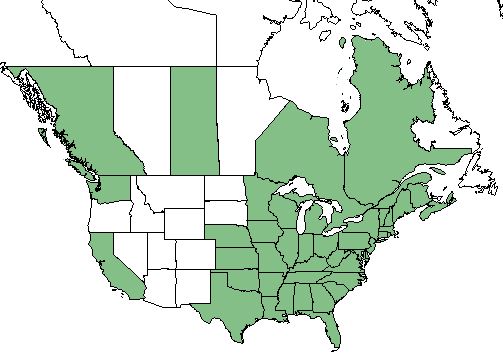Hypericum mutilum
Common name: dwarf St. Johnswort [1]
| Hypericum mutilum | |
|---|---|

| |
| Photo by John B | |
| Scientific classification | |
| Kingdom: | Plantae |
| Division: | Magnoliophyta - Flowering plants |
| Class: | Magnoliopsida - Dicots |
| Order: | Theales |
| Family: | Clusiaceae |
| Genus: | Hypericum |
| Species: | H. mutilum |
| Binomial name | |
| Hypericum mutilum L | |

| |
| Natural range of Hypericum mutilum from USDA NRCS Plants Database. | |
Contents
Taxonomic Notes
Synonyms: Hypericum mutilum L. ssp. latisepalum (Fernald) N. Robson; Hypericum mutilum L. ssp. mutilum
Varieties: Hypericum mutilum L. var. latisepalum Fernald; Hypericum mutilum L. var. mutilum
Description
H. mutilum is an annual/perennial forb/herb native to Canada and North America and introduced in Hawaii. [1]
Distribution
H. mutilum is found in: the eastern half of the United States; Washington; California; the British Columbia, Saskatchewan, Ontario and Quebec regions of Canada; Hawaii.[1] It is also found in Central and South America as well as Europe. H. mutilum var. latisepalum is distributed from southeastern South Carolina south to peninsular Florida and west to Texas. As well, H. mutilum var. mutilum is more widespread and is found throughout the normal distribution.[2]
Ecology
Habitat
H. mutilum is found in bogs, fens, marshes, shores, and other wet habitats, and H. mutilum var. latisepalum specifically can be found in marshes and other wet habitats.[2] Specimens have been collected from shallow water of marsh area, moist loamy sand, floodplains, small pond depression, and edge of river. [3] It grows best in partial shade.[4] The USDA Natural Resources Conservation Service lists this plant as a facultative wetland species that most often can be found in wetland habitats, but can also occasionally be found in non-wetland habitats as well.[1]
Associated species include Boehmeria sp., Triadenum sp., Carex longii, Eryngium prostratum, Paspalum sp., Chasmanthium sp., and Rhynchospora sp.[3]
Phenology
Generally, H. mutilum flowers from June until October.[2] It has been observed flowering in April through July. [5]
Fire ecology
H. mutilum is not fire resistant and has low fire tolerance. [1]
Conservation and Management
This species is considered vulnerable in Quebec, imperiled in Wisconsin, critically imperiled in Nebraska and Prince Edward Island, and an exotic species in British Columbia.[6]
Cultivation and restoration
Photo Gallery
References and notes
- ↑ 1.0 1.1 1.2 1.3 1.4 USDA Plant Database https://plants.usda.gov/core/profile?symbol=HYMU
- ↑ 2.0 2.1 2.2 Weakley, A. S. (2015). Flora of the Southern and Mid-Atlantic States. Chapel Hill, NC, University of North Carolina Herbarium.
- ↑ 3.0 3.1 URL: http://herbarium.bio.fsu.edu. Last accessed: June 2018. Collectors: Loran C. Anderson, V. Craig, H. Roth, Bill Boothe, marcia Boothe, Leon Neel, R.K. Godfrey, R. Komarek, J.M. Kane, Annie Schmidt. States and counties: Florida (Gadsden, Leon, Liberty, Wakulla) Georgia (Thoms, Grady) South Carolina (Georgetown)
- ↑ [[1]] Lady Bird Johnson Wildflower Center. Accessed: May 28, 2019
- ↑ Nelson, G. PanFlora: Plant data for the eastern United States with emphasis on the Southeastern Coastal Plains, Florida, and the Florida Panhandle. www.gilnelson.com/PanFlora/ Accessed: 22 MAY 2018
- ↑ [[2]] NatureServe Explorer. Accessed: May 28, 2019